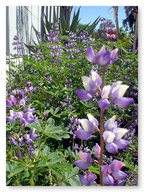Lupines (Lupinus spp.) are annual or perennial herbs or shrubs of the family Fabaceae (pea family) with members nearly worldwide. Over 300 lupine species are native to cool climates of the western U.S.
The official flower of Davis, as designated by the Davis City Council since the 1970s and reaffirmed as such in 1984, is a variety of lupine: Lupinus densiflorus var. aureus 'Ed Gedling' (aka Lupinus microcarpus var. densiflorus 'Ed Gedling'), commonly called the Golden Lupine. The Golden Lupine is a cultivar of a variety of lupine that is native to Davis.
Lupines can be seen along roadsides and drainage ditches in the Davis area and are often associated with spring, their typical blooming season. As the winter rains end and temperatures begin to rise, lupine blossoms fill fields and roadsides in the lower elevations of the state. As spring progresses and lower altitude lupines wither in the hot sun, conditions on the many mountain slopes and meadows improve and provide a perfect habitat for lupines to continue their fragrant ascent into the mountains.
Lupines have been cultivated since ancient times for enriching the soil, and the seeds of some species have been used as food. A drug has been extracted from lupine for management of cardiac arrhythmias. For many livestock animals, however, particularly sheep and horses, lupine is poisonous.
As a garden flower, the lupine is favored because of the various colors and the tall spikes of bonnet-shaped blossoms. The leaves are palm-shaped, with finger-like segments, and can be hairy to silky and silvery on both surfaces. The flowers are small, spurred at the base, and attached to the stem by a slender stalk (raceme). Typically, lupines grow from 10 to 24 inches tall, with one or more stems growing from a shortly branching taproot, from which comes the Latin-derived name (lupus for wolf, referring to the old false belief that the deep taproot wolfed soil nutrients).
Native Species
Six species of lupines are native within the city limits of Davis, and two others are native to other parts of Yolo County.
Chick Lupine (Lupinus microcarpus) is an annual native to Davis that can grow up to 2.5 feet tall. Its flowers can be pinkish purple or yellowish white, depending on the variety. It prefers full sun. The official flower of Davis, Golden Lupine, is the 'Ed Gedling' selection of the golden form of Chick Lupine.
Silver Bush Lupine (L. albifrons) is a shrub native to Davis that grows to about 4 to 5 feet tall and 2 to 3 feet wide. It prefers full sun and good drainage. It is very sensitive to root disturbance and can be difficult to install into a garden from a nursery pot. It thrives on neglect but can be short-lived in gardens when it gets watering and attention.
Miniature Lupine (Lupinus bicolor) is an annual or short-lived perennial that is native to Davis and can grow to a little over 1 foot tall. Its flowers are usually bicolored, dark blue and white or sometimes blue and lavender or blue and pink. It prefers full sun.
Summer Lupine (Lupinus formosus) is a perennial native to Davis that grows up to 2.5 feet tall. Cattle farmers often eradicate it because it is poisonous to cattle. Younger plants are more poisonous than older ones. It prefers full sun.
Sky Lupine (Lupinus nanus) is an annual native to Davis that can grow up to 2 feet tall. It prefers full sun.
Arroyo Lupine (Lupinus succulentus) is an annual native to Davis that grows 2 to 4 feet tall and 3 feet wide. It can colonize disturbed areas. It prefers moist clay or heavy soils in full sun.
Spider Lupine (Lupinus benthamii) is an annual native to the eastern part of Yolo County, starting just outside the eastern boundary of Davis. It grows a little over 2 feet tall and prefers full sun.
Big Pod Lupine (Lupinus pachylobus) is an annual native to the Yolo County foothills, including the Capay Hills. It grows a little over 1 foot tall.
For a listing of other plants found growing in Davis, check out our Town Flora and Native Plants. And for additional information about California native plants, visit the California Native Plant Society website.





